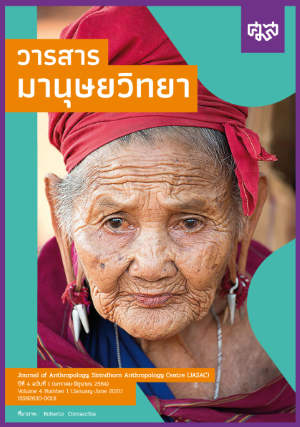Paw Karen’s Pagoda respect and tied wrist ritual: Ethnic identity and negotiation in Social and Cultural changes context. Case study: Ritual In Karen community , Supunburi, Uthaithani and Nakorn sawan Provinces.
Main Article Content
Abstract
This article is from the research work on the dynamics of Karen ethnic communities in the western region of Thailand, study area Suphan Buri, Uthai Thani and Nakhon Sawan, which have been funded by the Prince Maha Chakri Sirindhorn Anthropology Center. The rituals in the Karen community in all three provinces related to ritual creed are similar under the combination of traditional beliefs. Influence of Buddhism Including the use of such beliefs as a tool to show Karen identity in the social and cultural changes in Suphan Buri Province. That is the center of “Jaowat Cult”. The disappearance of the Jaowat and the reverberation of the Jaowat Cult that adapts to the development and tourism policies, as well as the fight on forest land rights, as well as the Uthai Thani province in which the Karen community still firmly adheres to the doctrine of the temple spirit. And is considered a cultural symbol that is used to connect the relationship between humans and nature While Karen outside in Nakhon Sawan province, who is a migrant worker Brought the original belief in the origin of the mother land together with the Buddhist belief to create a tradition of binding the wrist and using the area in Thai temples to declare the identity of the Karen state All three areas show the maintenance of ethnic identity in social and cultural changes.
Article Details

This work is licensed under a Creative Commons Attribution-NonCommercial-NoDerivatives 4.0 International License.
copyrights@ Journal of Anthropology, Sirindhorn Anthropology Centre (JASAC)
Princess Maha Chakri Sirindhorn Anthropology Centre (Public Organization), Bangkok, Thailand
More Information:
https://creativecommons.org/licenses/by-nc-nd/4.0/
References
ขวัญชีวัน บัวแดง. 2549. กะเหรี่ยง: หลายหลายชีวิตจากขุนเขาสู่เมือง. เชียงใหม่: ศูนย์ศึกษาชาติพันธุ์และการพัฒนา สถาบันวิจัยสังคม มหาวิทยาลัยเชียงใหม่.
ฉวีวรรณ ประจวบเหมาะ. 2547. “ทบทวนแนวทางการศึกษาชาติพันธุ์ข้ามยุคสมัยกับการศึกษาในสังคมไทย”. ใน ว่าด้วยแนวทางการศึกษาชาติพันธุ์. กรุงเทพฯ: ศูนย์มานุษยวิทยาสิรินธร (องค์การมหาชน).
ฉวีวรรณ ประจวบเหมาะ. 2551. “การจำแนกกลุ่มชาติพันธุ์: ปัญหาและข้อเสนอแนะ”. ใน ชาตินิยมกับพหุ วัฒนธรรม : การประชุมวิชาการ วันที่ 22-23 ธันวาคม 2551 ณ ศูนย์ประชุมนานาชาติ โรงแรมดิเอ็ม เพรส เชียงใหม่. เชียงใหม่: มหาวิทยาลัยเชียงใหม่ ศูนย์ภูมิภาคด้านสังคมศาสตร์และการพัฒนาอย่าง ยั่งยืน
ชาร์ลส์ เอฟ คายส์. 2541. “การเมืองเรื่องชาติพันธุ์ในประเทศไทย (Politics of Ethnicity)”, เอเชียปริทัศน์, 19(2): 25-50.2.
ณรงค์ อาจสมิติ. 2555. “รัฐชาติ ชาติพันธุ์ และอัตลักษณ์ไทดำ”, วารสารสังคมวิทยาและมานุษยวิทยา, 31(2):53 - 77.
ทวิช จตุวรพิทักษ์. 2538 . เสียงจากคนชายขอบ: ศักดิ์ศรีความเป็นคนของชาวลีซอ. เชียงใหม่: เครือข่ายชาติพันธุ์ศึกษา คณะสังคมศาสตร์, มหาวิทยาลัยเชียงใหม่.
นิวัฒน์ ฉิมพาลี. 2545. รายงานการวิจัย ผลกระทบของการพัฒนาเศรษฐกิจ – สังคมต่อสภาพแวดล้อมและชาติพันธุ์ในภูมิภาคตะวันตก. กรุงเทพฯ: ภาควิชามานุษยวิทยา คณะโบราณคดี มหาวิทยาลัยศิลปากร.
ประสิทธิ์ ลีปรีชา. 2557. “กระบวนทัศน์การศึกษาชาติพันธุ์สัมพันธ์”, วารสารลุ่มน้ำโขง, 10(3): 219 – 242.
ปิ่นแก้ว เหลืองอร่ามศรี. 2539. ภูมิปัญญานิเวศวิทยาพื้นเมือง ศึกษากรณีชุมชนกะเหรี่ยงป่าทุ่งใหญ่ นเรศวร. กรุงเทพฯ: สำนักพิมพ์โลกดุลยภาพ.
พยงค์ ศรีทอง. 2537. “คนโผล่ว กะเหรี่ยงเมืองสุพรรณ”, ศิลปวัฒนธรรม, 15(4): 100-111.
พัฒน์ระพี ขันธกาญจน์. 2526. “มาโบงเคิงสะล่อง กตัญญูต่อแผ่นดินของชาวกะเหรี่ยงโปว์ที่บ้านตะเพินคี่”, สารคดี, 9(105): 148-159.
ฟร้อนท์ เปรมพันธ์และคณะ. 2560. ภูมิปัญญากะเหรี่ยงกาญจนบุรี. กาญจนบุรี: สำนักศิลปะและวัฒนธรรม มหาวิทยาลัยราชภัฏกาญจนบุรี. เข้าถึงจากculture.kru.ac.th/th/wp-content/uploads/2018/01/karang.pdf
สมอง สุขยืน 2536. “ชาวเขาเผ่ากะเหรี่ยง จังหวัดอุทัยธานี”, ข่าวสารสถาบันวิจัยชาวเขา, 17(1): 46-48.
สุทิน สนองผัน. 2545. การศึกษาเปรียบเทียบสภาพการเปลี่ยนแปลงทางเศรษฐกิจและสังคมในชุมชนกะเหรี่ยงในเขตชายแดนไทยและพม่า ระหว่าง พ.ศ. 2490 – 2543. ราชบุรี: สถาบันราชภัฎจอมบึง
อมรา พงศาพิชญ์. 2531. เอกสารการสอนชุดวิชา 80207 ปัญหาการเมืองส่วนภูมิภาคและชนกลุ่มน้อย. พิมพ์ครั้งที่ 1. กรุงเทพฯ : สำนักพิมพ์มหาวิทยาลัยสุโขทัยธรรมาธิราช.
อานันท์ กาญจนพันธุ์. 2555. เจ้าที่และผีปู่ย่า พลวัตของความรู้ชาวบ้าน อำนาจและตัวตนของคนท้องถิ่น. เชียงใหม่: ภาควิชาสังคมวิทยาและมานุษยวิทยา คณะสังคมศาสตร์
Barth, F. 1969. Ethnic Groups and Boundaries: The Social Organization of Cultural Difference. Boston: Little, Brown and Company.
Bloch, M. 1973. “Symbol, Song and Dance, and Features of Articulation”, European Journal of Sociology, 15: 55-81.
Cohen, A. 1974. Urban Ethnicity. London: Tavistock Publication.
Eriksen, T.H. 1991. “The cultural contexts of ethnic differences”, Man, New Series, 26: 127–144.
Hayami Yoko. 1993. “To be Karen and to be cool: community, morality and identity among Sgaw Karen in northern Thailand”, Cahiers des Sciences Humaines, 29: 747-762 .
Keyes, C. F. 1966. “Ethnic identity and loyalty of villagers in northeastern Thailand”, Asian Survey, 6: 362-369.
Keyes, C. F. 1995. “Who are the Tai? Reflection on the Invention of identity”. In Lola Romanucci-Ross and George DeVos (Eds), Ethnic Identity: Creation, Conflicts and Accommodation. (pp. 136-160). Walnut Creek: Atlanta Mira Press.
Tadaw, S. H. 1962. “The Karens: Their Origin and Early Movements”. The Nation Supplement: Rangoon, July 8. Accessed on 10 September 2018, Retrieved from http://www.sac.or.th/databases/ethnicredb.
นายอังคาร คลองแห้ง, อายุ 51 ปี, บ้านภูเหม็นบน อุทัยธานี. (18 เมษายน 2562). สัมภาษณ์.
นาง ทองศรี คลองแห้ง, อายุ 73 ปี, บ้านคลองแห้ง อุทัยธานี. (19 มกราคม 2562). สัมภาษณ์
เจ้าวัดปองคลี, อายุ 65 ปี, บ้านอีมาดอีทราย อุทัยธานี. (17 เมษายน 2562). สัมภาษณ์.
นายวินัย ศรีฟ้า, อายุ 45 ปี, บ้านอีมาดอีทราย อุทัยธานี. (17 เมษายน 2562). สัมภาษณ์.
เจ้าวัดอ้วนใหญ่ เยปอง, อายุ 65 ปี, บ้านภูเหม็นบน อุทัยธานี. (17 เมษายน 2562). สัมภาษณ์.
เจ้าวัดมองตะลีตะ, อายุ 63 ปี, บ้านภูเหม็นบน อุทัยธานี. (17 เมษายน 2562). สัมภาษณ์.
สัมภาษณ์ พี่ทุ้ย (กะเหรี่ยงนอกนามสมมติ), วัดทองธรรมชาติปากน้ำโพเหนือ นครสวรรค์. (20 มกราคม 2562). สัมภาษณ์.
พี่สาย (กะเหรี่ยงนอก นามสมมติ), วัดทองธรรมชาติปากน้ำโพเหนือ นครสวรรค์. (20 มกราคม 2562). สัมภาษณ์.
พี่กบ (กะเหรี่ยงนอก นามสมมติ), วัดทองธรรมชาติปากน้ำโพเหนือ นครสวรรค์. (20 มกราคม 2562). สัมภาษณ์.

